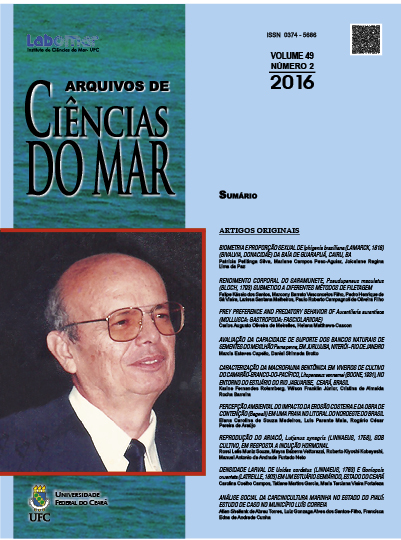Biometrics and sexual proportion of Iphigenia brasiliana (Lamarck, 1818) (Bivalvia, Donacidae) of the bay Guarapua, Cairu, BA
DOI:
https://doi.org/10.32360/acmar.v49i2.6551Keywords:
biometric behavior, bivalve molluscs, sex ratio.Abstract
The estuarine regions of the Brazilian coast are characterized as areas of extraction of molluscs, especially bivalves, much appreciated in food. Iphigenia brasiliana is an edible bivalve only in some Brazilian states, although it has great commercial potential. In this study we described the temporal variations in biometry and sex ratio of I. brasiliana in Guarapuá Bay, in the south of Bahia, between October and December/2000 and March and May/2001. For the biometric study of the population, were collected 76 individuals evaluating the length of the shell, total weight, weight of the soft parts, shell weight, income and sex ratio. Biometric monthly changes related to the size and weight in the population may be associated with physiological events of biomass accumulation and stage of development of the gonads. Regarding the sex ratio, it was found a ratio of M:F 1:1.3. The study can subsidize conservation actions and propitiate the ordering of extractive practices for this species of bivalve in the region, promoting, thus, its potential for marketing and food.
Downloads
Published
Issue
Section
License
1. Proposta de Política para Periódicos de Acesso Livre
Autores que publicam nesta revista concordam com os seguintes termos:
- Autores mantém os direitos autorais e concedem à revista o direito de primeira publicação, com o trabalho simultaneamente licenciado sob a Licença Creative Commons Attribution que permite o compartilhamento do trabalho com reconhecimento da autoria e publicação inicial nesta revista.
- Autores têm autorização para assumir contratos adicionais separadamente, para distribuição não-exclusiva da versão do trabalho publicada nesta revista (ex.: publicar em repositório institucional ou como capítulo de livro), com reconhecimento de autoria e publicação inicial nesta revista.
- Autores têm permissão e são estimulados a publicar e distribuir seu trabalho online (ex.: em repositórios institucionais ou na sua página pessoal) a qualquer ponto antes ou durante o processo editorial, já que isso pode gerar alterações produtivas, bem como aumentar o impacto e a citação do trabalho publicado (Veja O Efeito do Acesso Livre).

